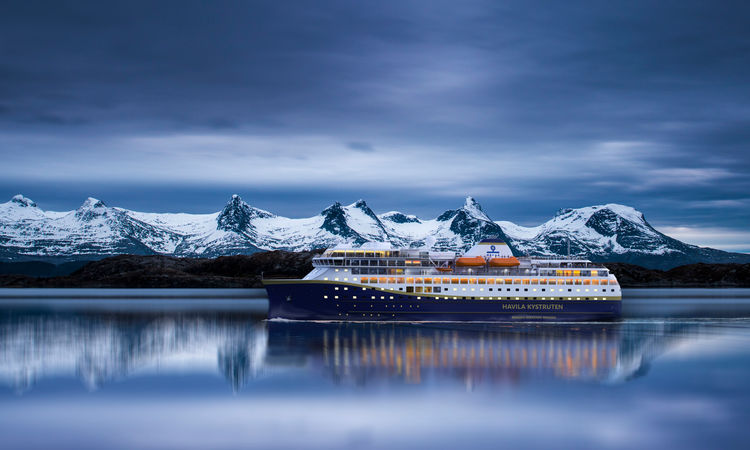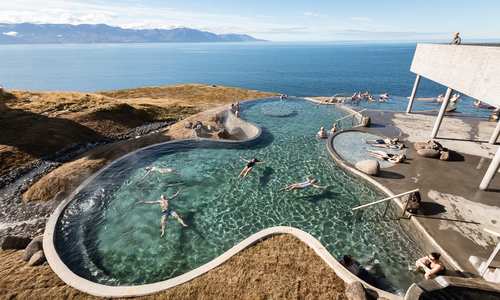Article content
1 September 2006 by Duncan Mills
As a veil of mist drifts across the jagged black lava field, a burst of north Atlantic wind buffets both rider and horse. Beads of water drip down my Icelandic horse’s long fringe and onto the sootblack bridle path beneath us, the gravel underfoot clacking and clopping as we edge forward. In the distance, a perfect conical peak rises from the plateau, patches of ice hanging from its sides like melting ice cream, while on either side of me the trail drops down to a series of little caves. In this setting – the wind, the light, the gnarled landscape – it is easy to believe in local fairy tales of trolls lying in wait for unsuspecting riders.
Leaning to my right, I peer closer at a cave, but the horse snorts loudly, shaking the spray off his face as if to say “nothing in there”, and with a lurch climbs up a tussock. And then we are back onto black pumice stone once more, the cool air carrying with it the smell of horse and the salt of the ocean. This is the scalded, twisted terrain of the Reykjanes Peninsula in south-west Iceland, the point at which the tectonic plates of Europe and America collide, the surrounding charred rock thrust up from below through many ages. Trotting through the volcanic debris, my steed and I ride with two hooves in Europe and two in America. Closer to Greenland than to Scandinavia, for the Vikings this world of fire and ice formed a stepping-stone across the north Atlantic. From here, they sent out colonists to Greenland and then Vinland – as local legend Leifur Eriksson called the part of north America that he discovered long before Columbus sailed. Today a statue of Eriksson stands outside Reykjavik’s Hallgríms church.
His achievements are recounted in the ‘Saga of the Greenlanders’ within the Flateyjarbók, the largest of Iceland’s medieval vellum books, its edges frayed by time and transportation. In many ways the sagas are a focal point for Icelanders, a place of national connection. “We Icelanders can trace our ancestors back to the beginning,” says Jon Kari Hilmarsson, a young-at-heart Reykvikingur. “Sometimes this goes way back before settlement,” he adds, before looking up to acknowledge a stylish group filing into Vegamot, one of the hippest bars in town. “We only have a small population, so we all know everyone.” Yet for the first Viking settlers, Iceland was an empty new world. Hardy souls started to arrive on this uninhabited island around 870 AD, bringing with them everything they might need to survive: grain to sow in the spring, nets and lines to catch fish in the lakes, rivers and seas; tools for iron working; sheep, goats, pigs, poultry and, of course, horses. A millennium later, my own horse – rather like an Exmoor pony – strolls into the stables for a welldeserved feed.
Across the country, horses like this are still widely used for the annual livestock round up each autumn. But out on the arterial ring road around the island, lorries and giant four-by-fours rule, ready for the onslaught of whatever forces nature might muster. Here the rain clouds clear to reveal isolated cattle farms, their brightly painted red or blue roofs standing out amid lush green pasture. But inland, vast glaciers are melting with the spring, swelling rivers and waterfalls across the country.
At the damp, mist-cloaked village of Vik, on the southernmost tip of the country, the surging Atlantic meets a beach of soot-black sand. Waves pound the base of three tall offshore spires known as the Reynisdrangar, the Troll Rocks, said to be petrified trolls caught by the sun as they were trying to drag a boat ashore. In the headland above, kittiwakes and puffins make their nests, while Arctic terns swoop along the flat foreshore. Back on the road, great peaks rise up on both sides from the valley floor like monstrous tidal waves, before flattening out along their tops, from where water cascades over the edge some 62 metres down to a gravel river bottom at Skógarfoss.
Inland, the water moves in the other direction, violently gushing up out of the ground amid mineral-streaked mounds and bubbling hot springs at Geysir. Further along the Golden Circle tourist trail is Gullfoss, a suitably epic double-horseshoe waterfall, which freezes solid in the depths of winter, but flows with awesome force now, steam rising from the depths of the river chasm, casting rainbows amidst a tumult of noise and energy. From Gullfoss, I clamber up into one of the ubiquitous monster trucks to join a group heading up to the Langjökull Glacier. As the road turns to broken gravel and then slipping mud, we pass two cyclists heading over a ridge. Our tour leader, on a day off from his duties as a fireman in Reykjavik, runs a hand through his white blonde hair and tilts his sunglasses up towards the peaks ahead. “They don’t know what they’re letting themselves in for,” he says, steering off the track and up onto the melting ice of the lower reaches of the glacier, trickles of deep blue water melting its edges and turning to mud. Several kilometres higher up, where the snow is kneehigh, we go for a snowmobile ride over the glacier. The clouds suddenly close in all around and a silent white-out ensues. Minutes later it clears, and rock and ice, land and sky, appear once more.






